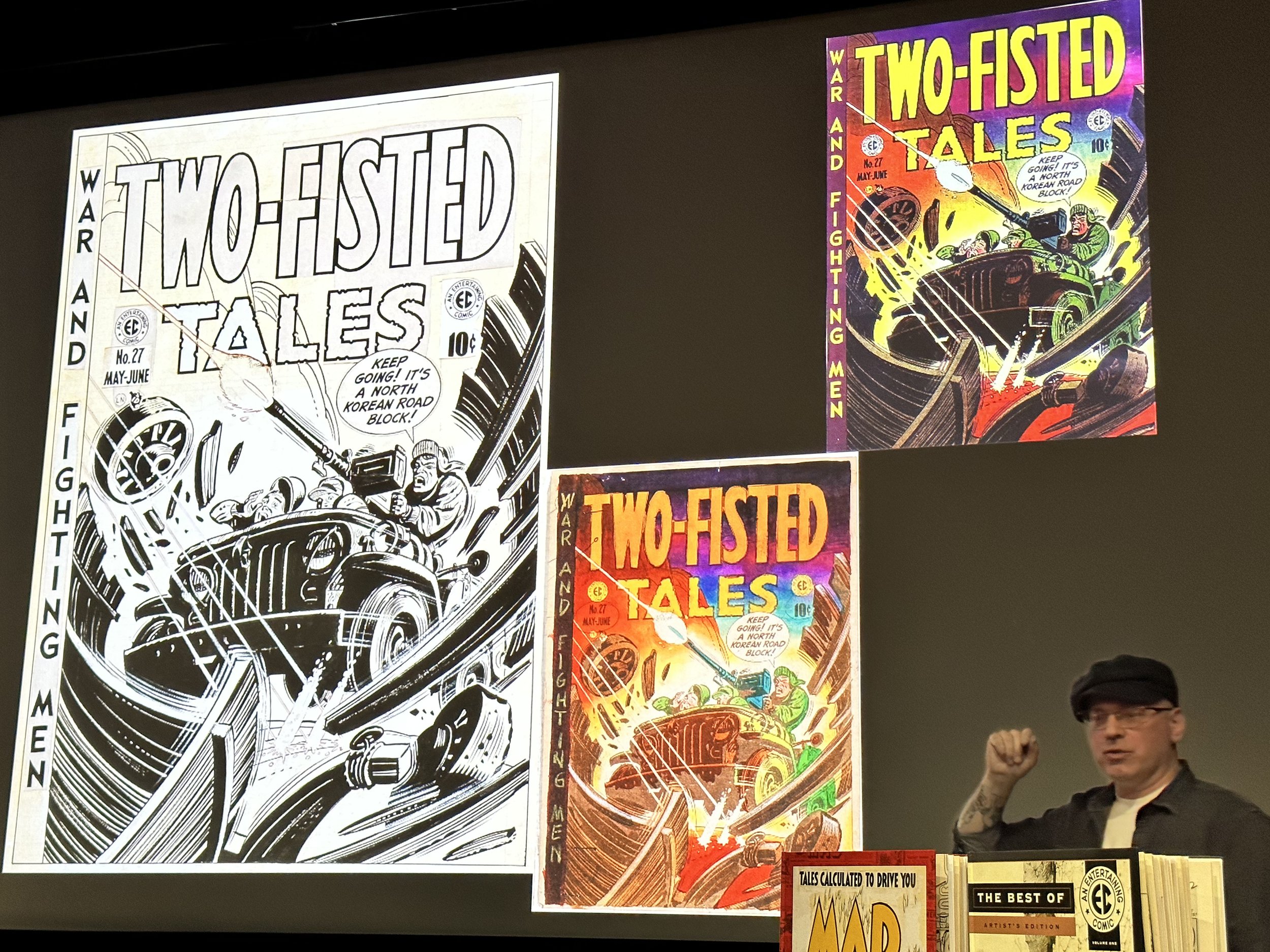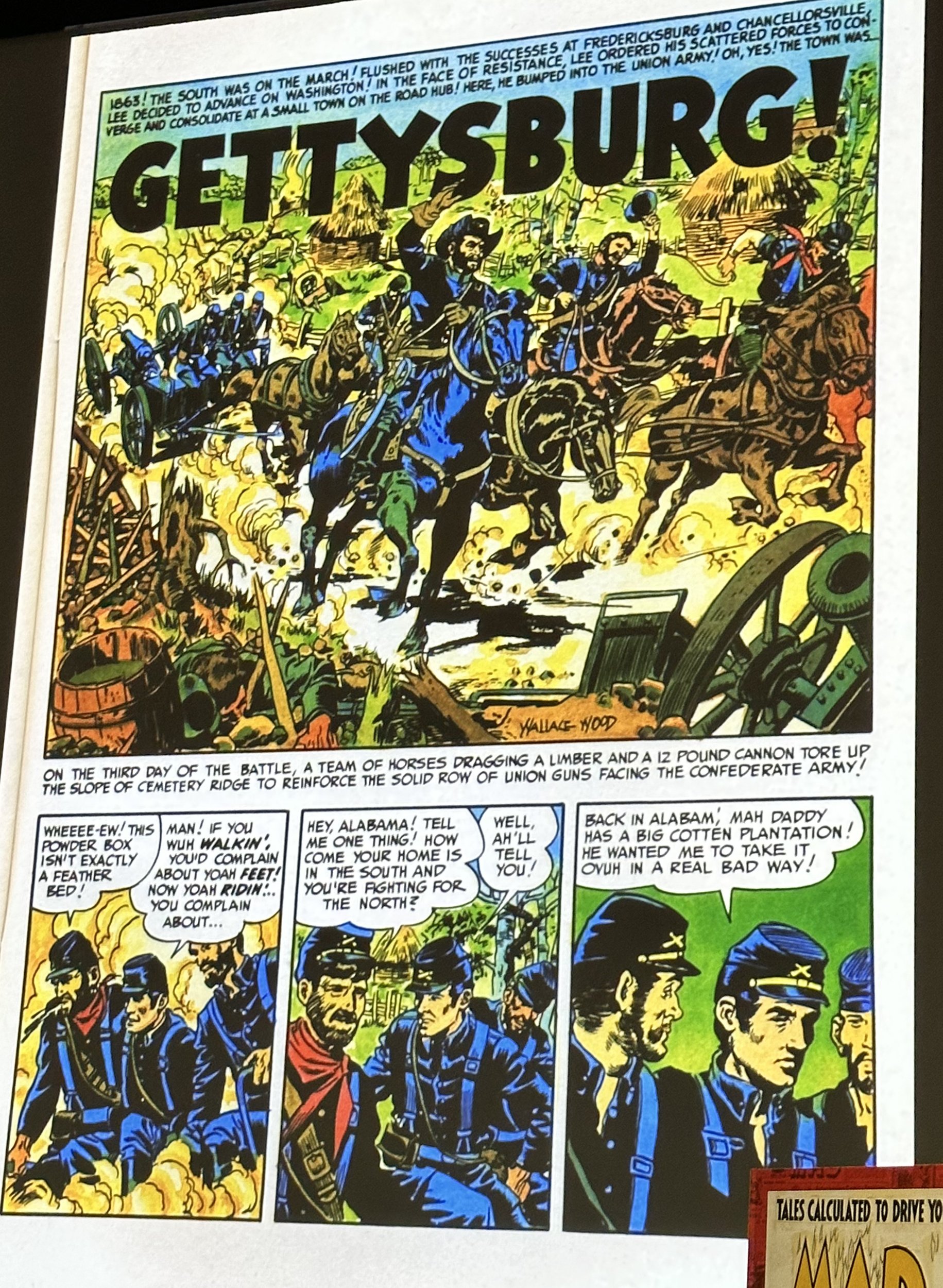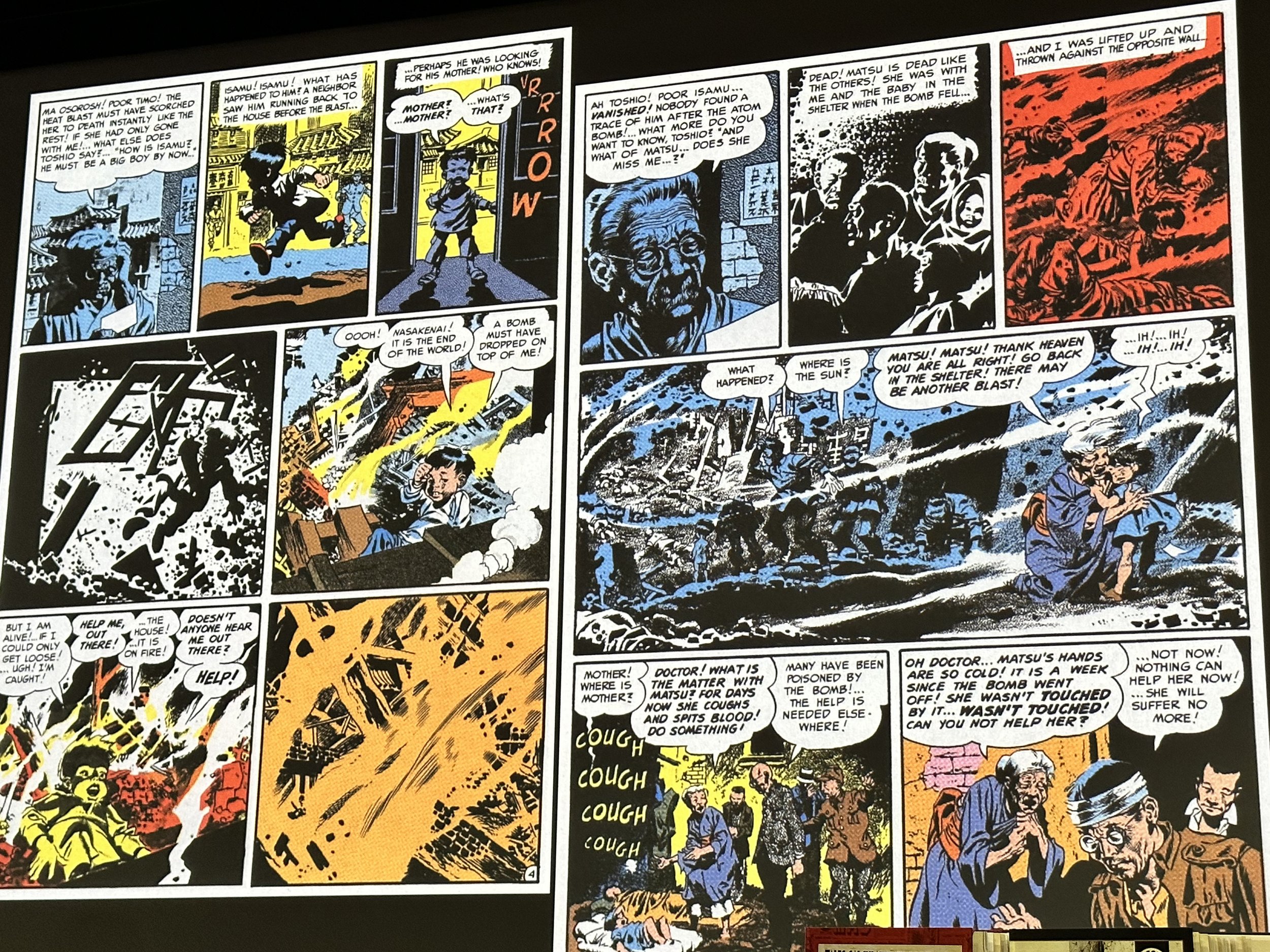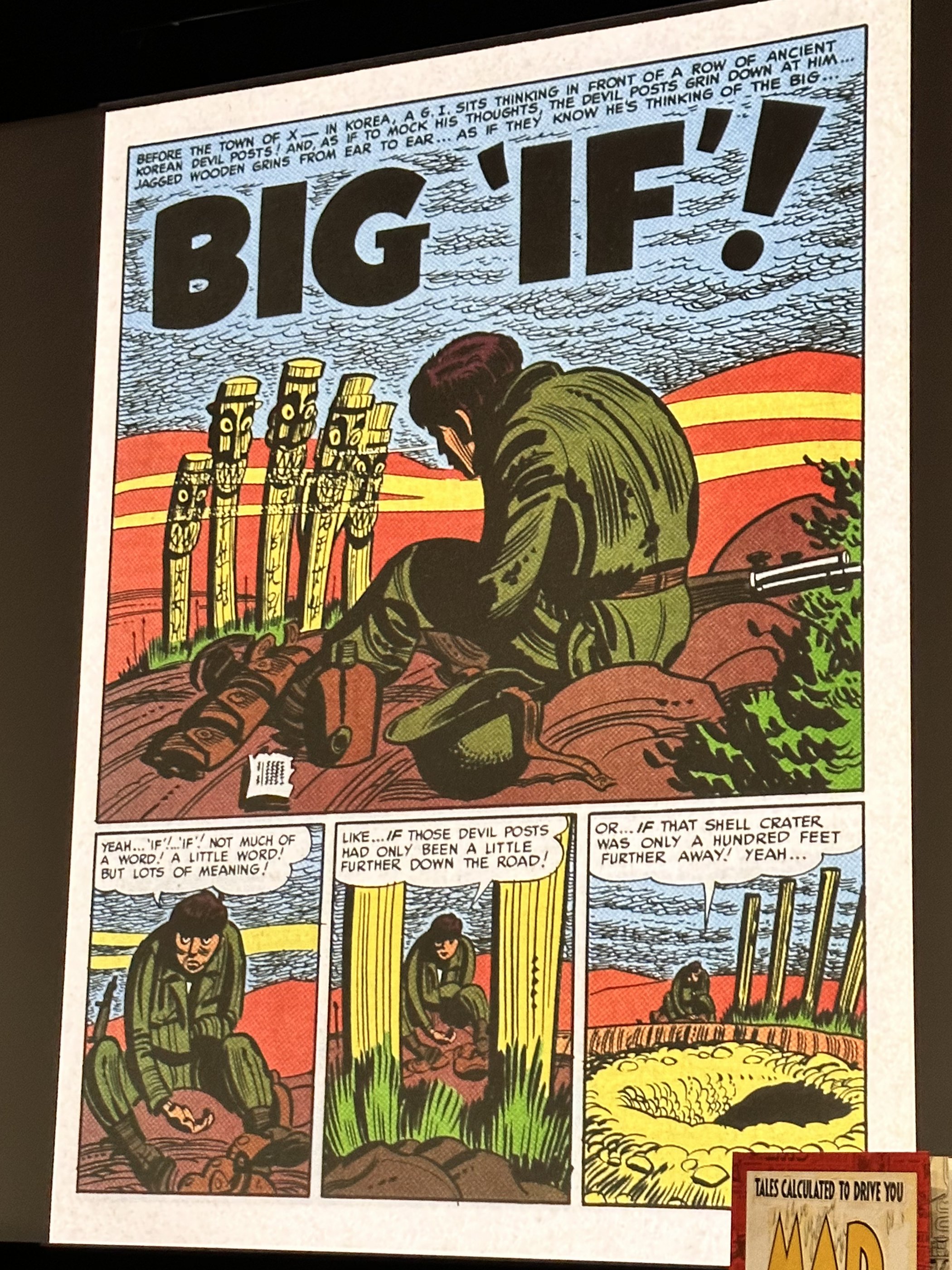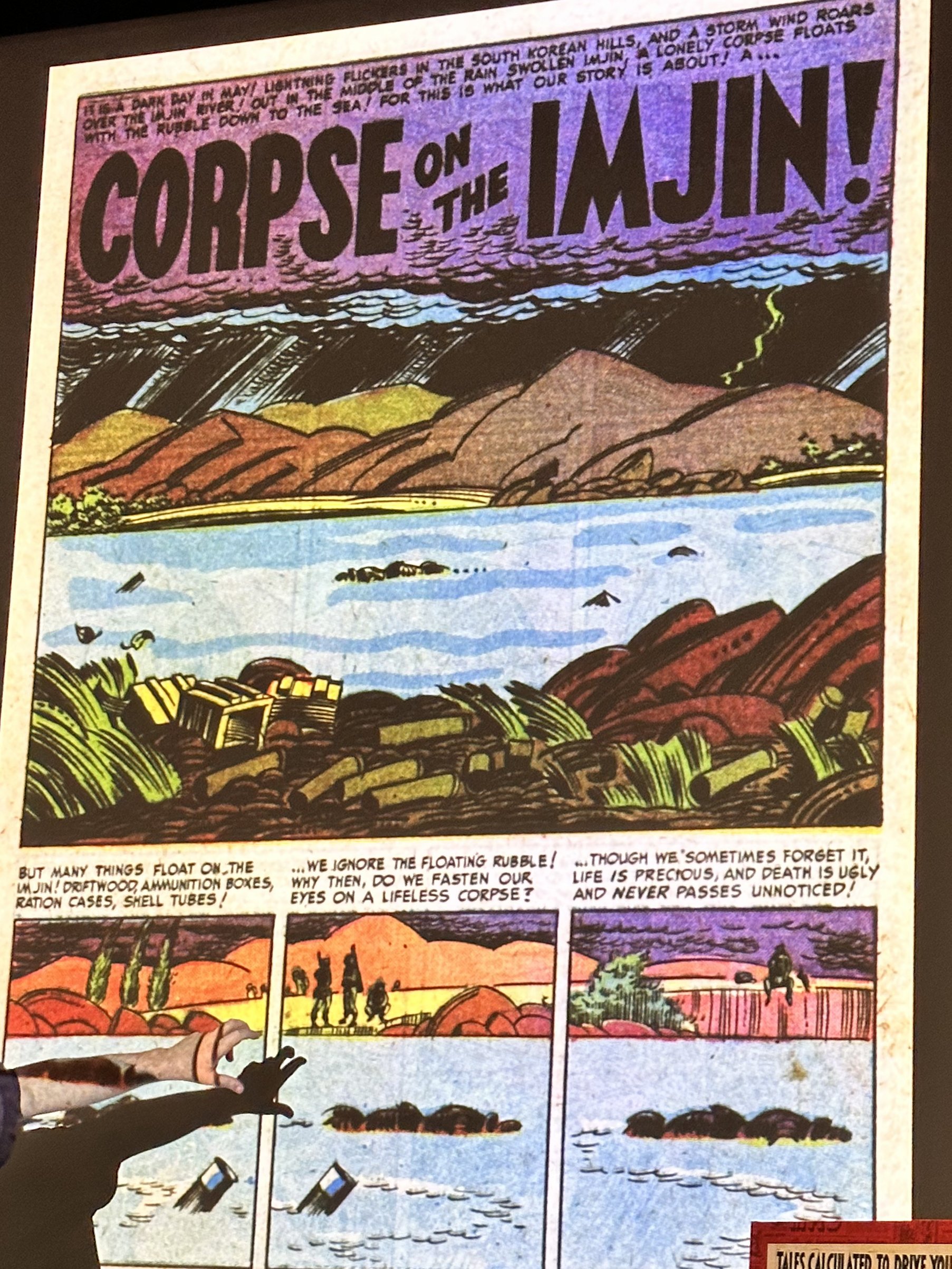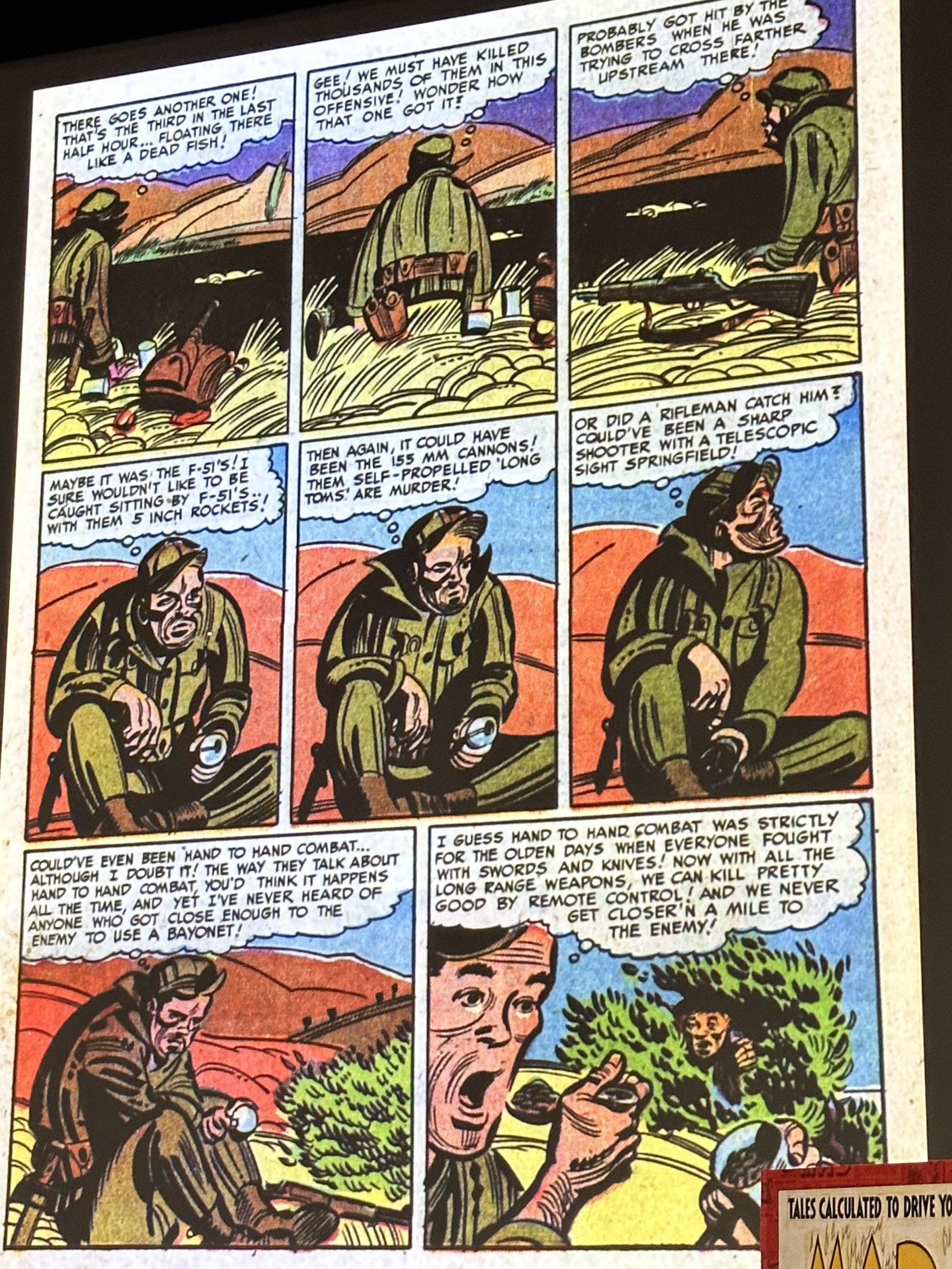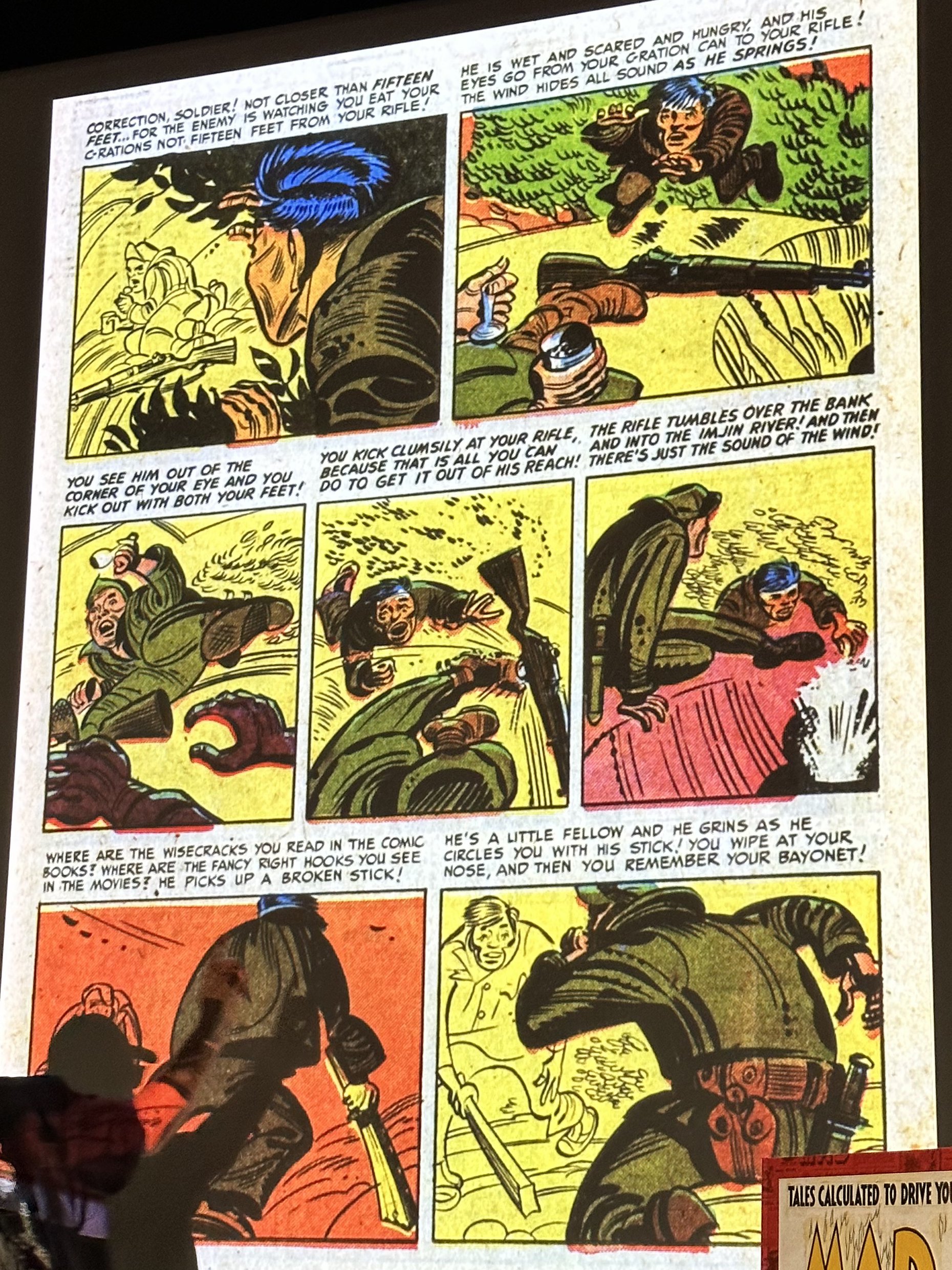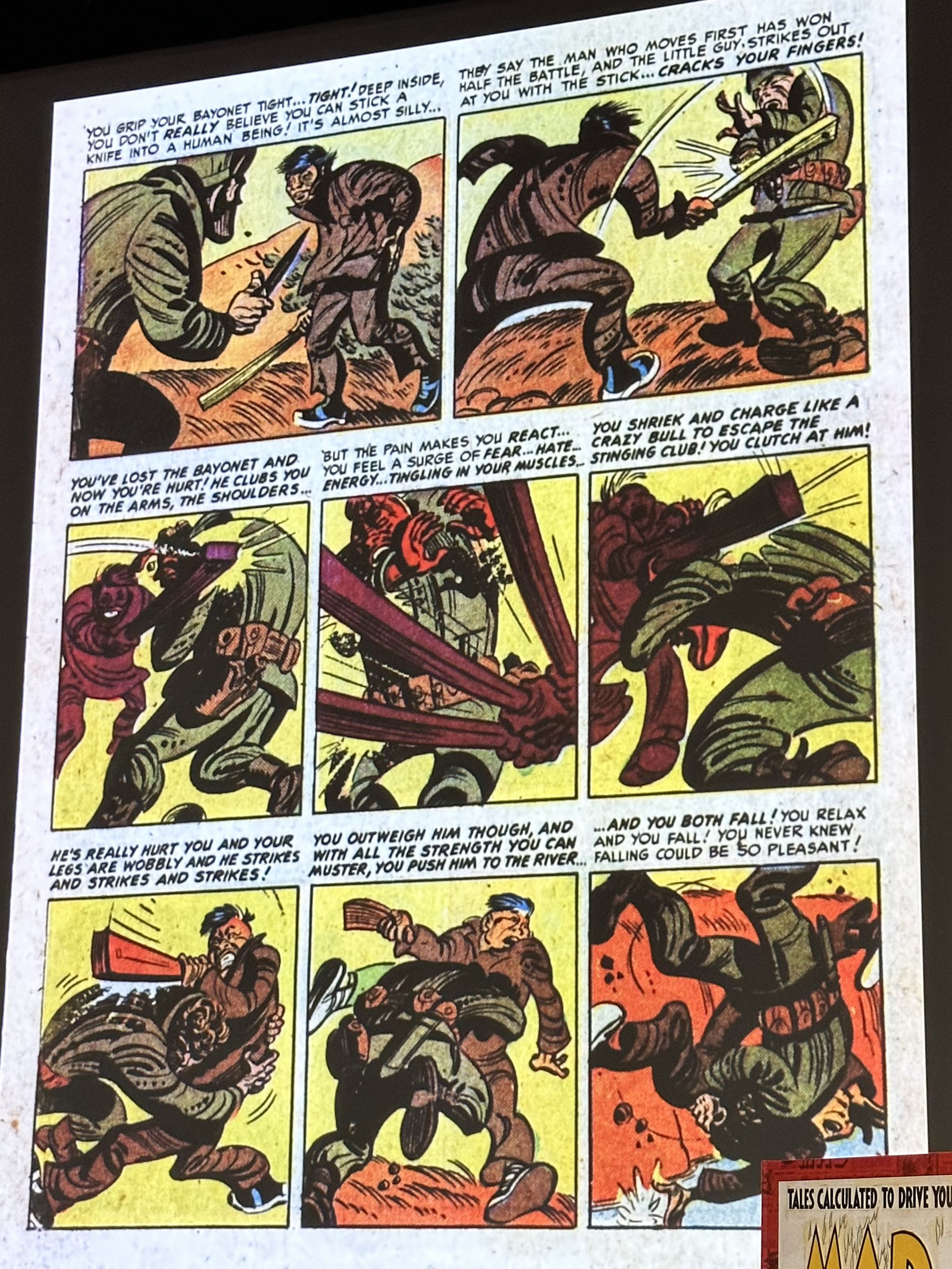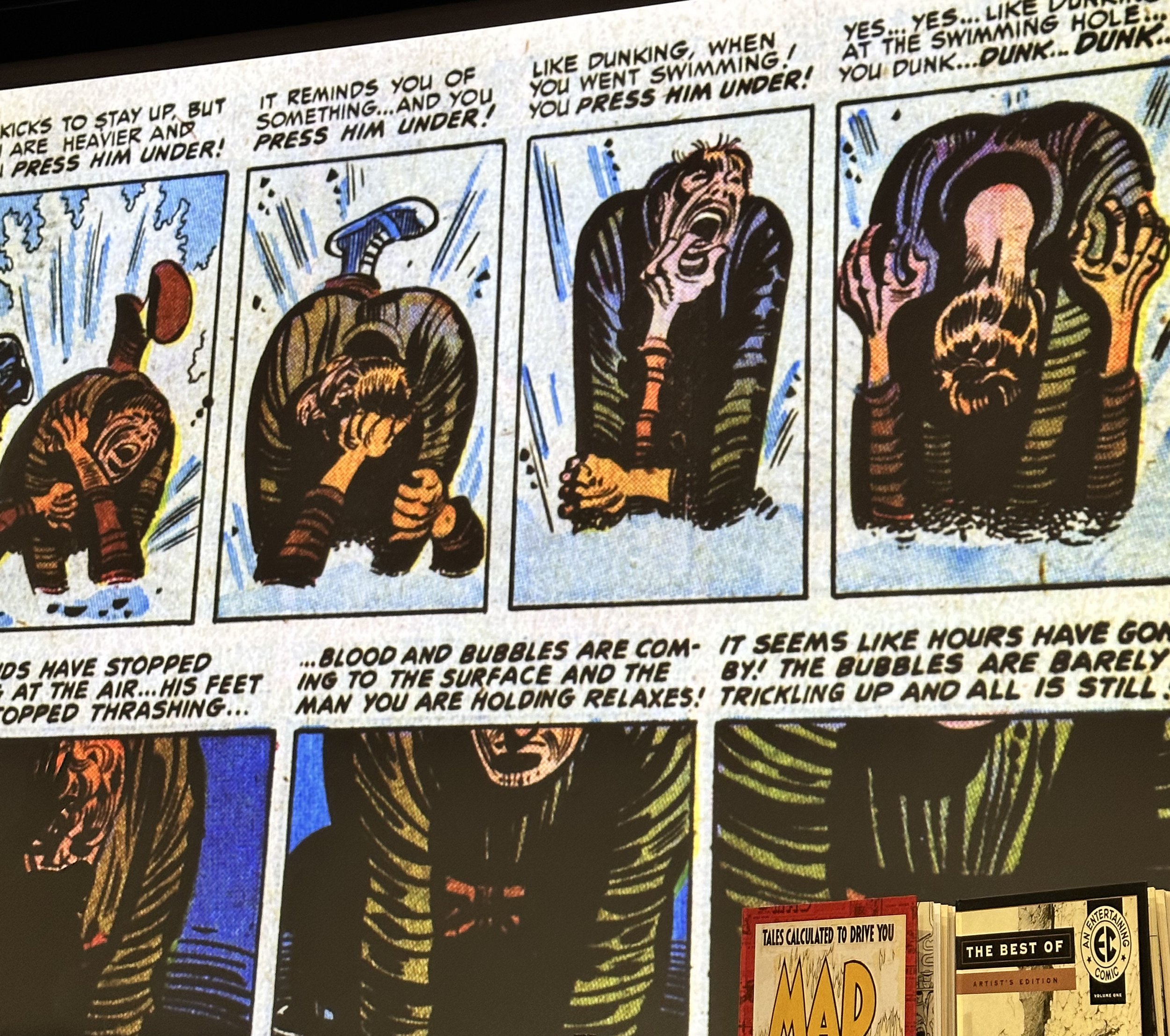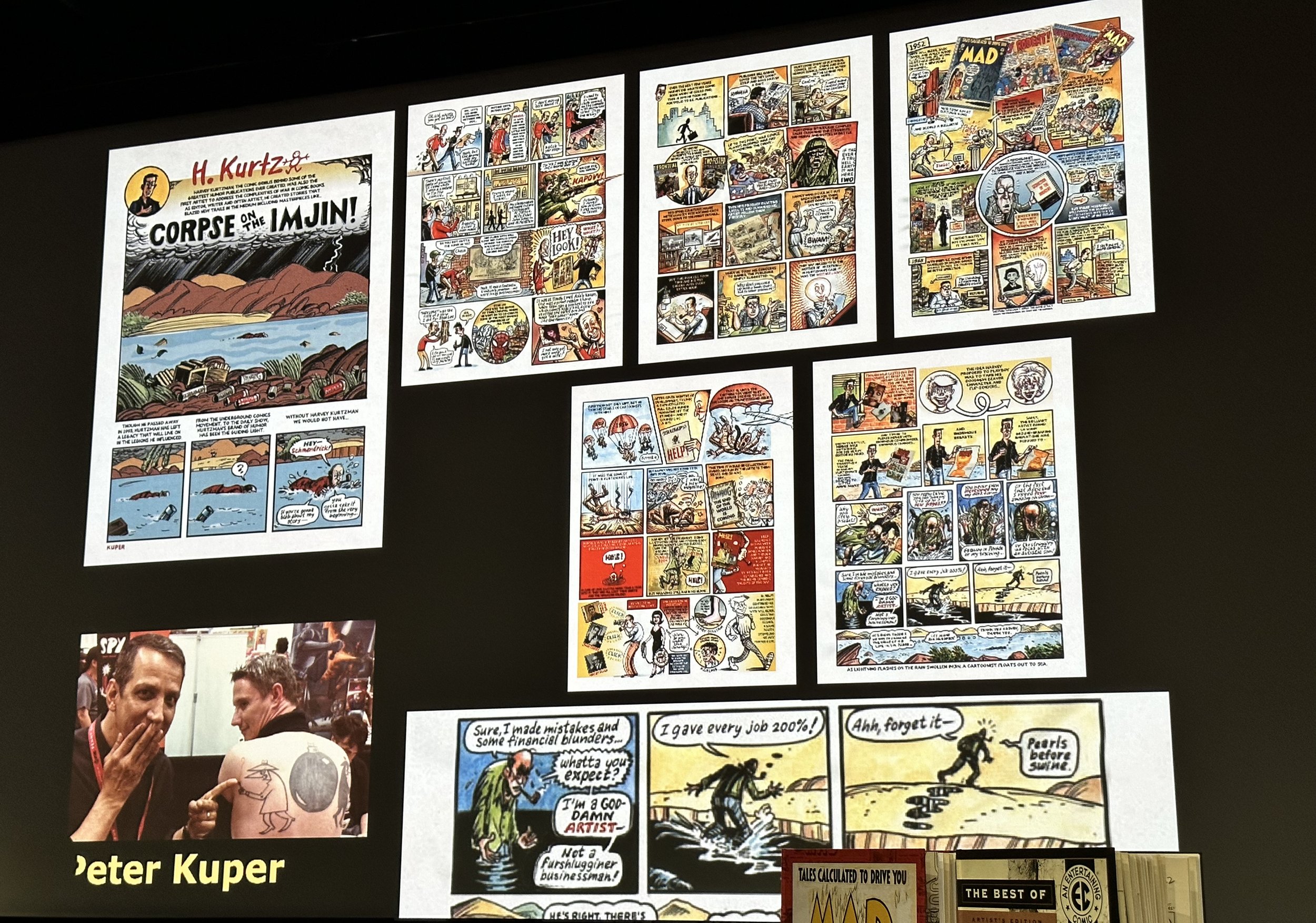HARVEY KURTZMAN! Mad Pre-Postmod Genius of 1950s Comics
Hello again, everyone! Happy almost March!
I had the pleasure, once more, of sitting in on a lecture this week on Monday 2-20-23 at Art Center in Pasadena, and I wanted to share some of the excellent artwork and information I learned more about at the Absolute LEGEND Harvey Kurtzman. The lecture was lead by EC historians Thommy & Josh Burns, as well as Professor Michael Dooley. For more information on Josh and Thommy preeminent EC Comics experts, you can join the EC Comics Fan Addicts on Facebook, or their Website! Michael is amongst other things, the creative director of Michael Dooley Design and teaches Design History at Art Center and LMU. He’s also a book editor, Print magazine contributing editor, and writer of feature articles and critical essays for Print and other books and publications. He's been an instructor at UCLA Extension, Otis College, and other schools, and a lecturer at the Hammer Museum, LACMA, universities, educational conferences, and other institutions.
This lecture, as noted, was more focused than just on the Comics Company itself and really shed a light on the man and work of Harvey Kurtzman (1924 - 1993). (Fun aside from E.C.’s origins – They were first known as Educational Comics founded by Max Gaines. He came from the company All-American Publications. Eventually they merged with DC Comics. They started out making Picture Stories from the Bible. Which as you can imagine… SUPER Profitable for the time! (not at all). So he began the new company with a plan to market comics about science, history, and the Bible) Max Gaines passed unexpectedly and Bill took the helm making what they are now famous for.
Kurtzman while serving during WWII as an illustrator making instruction manuals, posters, and flyers for the military he would also draw funny comics as well. After he was discharged he freelanced around doing various strips that mostly paid the bills. He made some fun stuff like ‘Hey Look’ which was loads of gags and filler pages done for Timely Comics (later to become Marvel Comics with the then small time Stan Lee at the helm. But when he saw what E.C. was getting up to he applied and got his first gig with them and was assigned to illustrate a commission from Columbia College for an informational about Venereal disease! ‘Lucky Fights it Through’ was his start there!
Lucky Fights it Through 1949
While at E.C. he found the ideal platform for his innovative ideas. He wasn’t a huge fan of the books they were making for the reasons they stood out which not so much about their great illustration, but they were morality stories and had some pretty graphic imagery. Several of the early sci-fi and horror books of EC's "New Trend" line featured Kurtzman art and plots. Yet Kurtzman wasn't as interested in fantasy as much as real-life. He thankfully after having a chat with Bill Gaines about Al publishing seven titles at the time, he wanted in on the action! So he then pitched some action/adventure comics to the team which began a super amazing journey and exercise in cinematic comic panels, and then ultimately also lead to the creation of one of the (demonstrably) most influential pop culture magazines ever! MAD MAGAZINE! Not to say ‘Two Fisted Tales’ and ‘Frontline Combat’ were in any way lesser books as they have a very different vibe and beauty, which I’ll get to later. The biggest thing was not doing Poetic Justice Revenge Stories. Harvey says “ I can do a Funny Book!”
Mad Magazine began its life as a Comic Book. The first couple of issues did really poor. Like, 1-3 did not sell. The subject matter of the books were specifically based in what E.C. was doing well and parodying that. But then Issue #4 really took off with the Introduction of SUPERDUPERMAN!!! This was a huge turning point where they began really lampooning what was in the cultural zeitgeist. In SUPERDUPERMAN they even satirized the war that was waging between the hero comics at the time that was Captain Marvel being too close to Superman see -National Comics Publications, Inc. v. Fawcett Publications, Inc. - but iconically this was the start of something mega.
Another insanely fun thing you can see illustrated above and below was the details. They called it “chicken fat” where they just lay in details that are, upon first look, not much. But when you really take the time to “chew” on it you really get into some fun stuff. shown below is a load of the chicken fat that was in that first splash panel. Artists would follow his layouts to an insane degree. He wanted it how he wanted it or it wasn’t up to snuff. He even went as far as to send one of his assistants down in a submarine to get the sounds right for the sound effects. He was that meticulous.
Examples of his layouts
“Chicken Fat” in Superduperman splash panel. One is Bill Gaines in the Hat, making fun of Wally Wood (one of the most prolific of the E.C. artists. Just gags on gags on gags.
They Went After EVERYTHING! From Cinema, to Literature, Pop Culture, Politics, you name it! They made fun of hearings that were ongoing. Including the Comics Code hearings, turning the spectacle into a gameshow! EVEN BREAKING THE FOURTH WALL as we see in the Robinson Crusoe panel at the end there.
Starchie!!!
Early Hey Look Breaking the Fourth Wall.
The guys at MAD had some serious guts to be publishing what they were, especially as the War comics were putting them up for investigations from the FBI! There were declassified documents regarding the dossiers they held on Kurtzman. Check out the book HARVEY KURTZMAN The Man Who Created Mad and Revolutionized Humor in America By Bill Schelly. Foreword is by Terry Gilliam. The biography–642 pages with 250 illustrations, including photos–reveals the true story of Harvey Kurtzman. New interviews with his colleagues Hugh Hefner, Robert Crumb, Jack Davis and others, and revealing new information, including legal battles with Bill Gaines, and details of the McCarthy-era FBI investigation. Insane Stuff!! CONTRARY to popular belief the move from Comic to Magazine was not due to the Comics Code Authority cracking down (the ultimate demise of E.C. Comics). It was due to the brilliant writing, fantastic art and success of the book that at issue 24 became a magazine. Harvey wanted a “slick” as it were, and Bill Gaines trust and belief in it was huge. He sunk everything that had into the magazine to MAD Success. So much so that it went to a second printing which is almost unheard of in periodicals. It was ultimately his demise for the Magazine as well as he wanted 51% stake in the books. Harvey was an amazing talent, but given the opportunity he could overdo it. To the extent when he first worked with Hugh Hefner at Playboy, they say he was given an unlimited budget - and he still went over!
For me was one of the best things of my childhood was my subscription to Mad Magazine. I felt like such a lucky kid that my grandmother had been rad enough to sign me up for a subscription to Mad Magazine. I also had friends whose parents were collectors, and had re-issues, the paperback compilations and more. So thankfully I’ve been well versed in Mad Magazine my whole life. I watched Mad TV when it came out (first episode when Appointment Television was a thing!) I’ve even had the fortunate ability to work with their more recent ( up to 2019) editor in chief Bill Morrison (Willardson and Associates, The Simpsons, Futurama, and eventually Mad Magazine) back in my Acme Archives Days! I’ve idolized the illustrators and writers of the book for my entire life. My Very first San Diego Comic Con I RUSHED over immediately to meet Sergio Aragones! (if you are unfamiliar - per his Wikipedia - Sergio Aragonés Domenech is a Spanish/Mexican cartoonist and writer best known for his contributions to Mad magazine and creating the comic book Groo the Wanderer. Among his peers and fans, Aragonés is widely regarded as "the world's fastest cartoonist") A man full of whimsy, nonsense, and non sequiturs. Al Jaffee, Mort Drucker, Frank Jacobs, Dave Berg to name a few. All the immensely talented people who worked on this publication through the years.
Bill Morrison in his office
Bill Morrison gave me his personal copy of the Mr. Burns Book, and a personal copy of a Sergio Aragonés Comic Book, can’t seem to locate my signed copy of Groo for this photo…
The Next portion of the lecture we went more in depth on the War Stories done by Kurtzman, where the real Cinematic qualities were. This is where he really shined, and got him in trouble! For ‘Two Fisted Tales’, it started off as ‘He Man Adventure’ and quickly went to ‘War and Fighting Men’. These stories portrayed more than just a quick war time story. We were shown an empathetic and “starkly truthful” view of what it’s like to be a soldier.
These books spoke about the real life situations. The FBI Investigations spoke of the books that they painted a picture of the inevitability of the horrors of war. Above we see three states of being in one cover. Futility, optimism, and death. The books also were protests of war, but not anti war specifically. They also showed the mentality of a soldier, the stories that they tell are much different than a standard protest. They were about the people in battle rather than the battles themselves. Sometimes even not revolving around the soldiers. In Hungnam the story revolves around a dog, one was around a baby. The hyper focus on these vignettes are poignant and stunningly beautiful. The illustrations tell such amazing stories, and the details are all on point due to Harvey’s need for accuracy. Down to the last button.
Above I spoke about ‘Corpse on the Imjin' for good reason. For the 1950’s this type of story telling was pretty unique. The camera view we see showcases the same subject across a panorama of panels. Then it also uses cinematic techniques like the 180 degree line, in order to break it! Basically the 180-degree rule states that two characters (or more) in a scene should always have the same left/right relationship with each other. The rule dictates that you draw an imaginary line between these two characters (or subjects) and try to keep your camera(s) on the same side of this 180-degree line. But we see him break it in this so that it doesn’t allow you to follow who is doing what. Because at the end of the day the job is to survive. One is a victor, the other is not. The Dead Body in the first panel returns at the end so it ends where it started. Showcasing a futility of war, but also not specifically calling out sides. The Narrator also starts wondering how the body got there in the first place, then we come to find him in the same predicament, and ultimately another body floats down the river.
Then for levity a Mad parody of this done by Peter Kuper.
After all of these amazing comics he went on to make Trump for Hugh Hefner, only lasted two issues. This was the closest he came to the specific humor mag he wanted. Later on he made Humbug ( 11 issues), Jungle Book, and ultimately HELP, which gave us Goodman Beaver!
Look at ALL That Chicken Fat!!!!
The Best of them all was 'Goodman vs. Playboy' (issue #13, February 1962), where we meet LITERAL Archie characters.. But they’ve all turned evil and are into the playboy lifestyle. After we met all of them in Starchie, this version is not so tame! They showcase the Goodman (the Square, literally his balloons are squares) turn out to have signed a pact with "the Devil", which is clearly Hugh Hefner in this instance.
While mostly everyone had a good laugh at it, Kurtzman was sued by the Archie Team! But then this lead to the next chapter for Kurtzman and Playboy which was Little Annie Fannie!
Ultimately this led him down the path to entertainment, Animation, commercials and an inevitable return to MAD. But the man, the myth, the Legend inspired, or gave jobs to some of the most notable characters in the world. From John Cleese, Terry Gilliam, R. Crumb, Gloria Steinem, Stan Freberg, the list goes on on and on! Kitchen Sink Press published a compilation book, 'Kurtzman Komix' (1976), which had a foreword by Robert Crumb. They also reprinted 'Goodman Beaver' (1984), 'Hey Look' (1992) and 'Harvey Kurtzman's Jungle Book' (1988). Kurtzman made a graphic contribution to Marion Vidal's 'Monsieur Schulz et ses Peanuts’ (Albin Michel, 1976), an essay about Charles M. Schulz’ 'Peanuts’, illustrated with subversive parodies of the comic. Kurtzman received two Lifetime Achievement Awards, one (1972) from the European Academy of Comic Book Art, the other (1977) an Inkpot Award. In 1989 he was inducted in the Will Eisner Hall of Fame. But don’t let this lecture recap stop you from finding ALL of the good stuff that Harvey Kurtzman did for entertainment, comics, movies, and more! Just a TRUE Legend and Genius!
From Josh and Thommy’s personal collections!




















